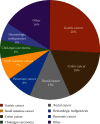Prediction of Prognostic Risk Factors in Patients with Invasive Candidiasis and Cancer: A Single-Centre Retrospective Study
- PMID: 35692595
- PMCID: PMC9185171
- DOI: 10.1155/2022/7896218
Prediction of Prognostic Risk Factors in Patients with Invasive Candidiasis and Cancer: A Single-Centre Retrospective Study
Retraction in
-
Retracted: Prediction of Prognostic Risk Factors in Patients with Invasive Candidiasis and Cancer: A Single-Centre Retrospective Study.Biomed Res Int. 2024 Mar 20;2024:9797025. doi: 10.1155/2024/9797025. eCollection 2024. Biomed Res Int. 2024. PMID: 38550075 Free PMC article.
Abstract
Background: Invasive candidiasis is a common cancer-related complication with a high fatality rate. If patients with a high risk of dying in the hospital are identified early and accurately, physicians can make better clinical judgments. However, epidemiological analyses and mortality prediction models of cancer patients with invasive candidiasis remain limited.
Method: A set of 40 potential risk factors was acquired in a sample of 258 patients with both invasive candidiasis and cancer. To begin, risk factors for Candida albicans vs. non-Candida albicans infections and persistent vs. nonpersistent Candida infections were analysed using classic statistical methods. Then, we applied three machine learning models (random forest, logistic regression, and support vector machine) to identify prognostic indicators related to mortality. Prediction performance of different models was assessed by precision, recall, F1 score, accuracy, and AUC.
Results: Of the 258 patients both with invasive candidiasis and cancer included in the analysis. The median age of patients was 62 years, and 95 (36.82%) patients were older than 65 years, of which 178 (66.28%) were male. And 186 (72.1%) patients underwent surgery 2 weeks before data collection, 100 (39.1%) patients stayed in ICU during hospitalisation, 99 (38.4%) patients had bacterial blood infection, 85 (32.9%) patients had persistent invasive candidiasis, and 41 (15.9%) patients died within 30 days. The usage of drainage catheter and prolonged length of hospitalisation are the dominant risk factors for non-Candida albicans infections and persistent Candida infections, respectively. Risk factors, such as septic shock, history of surgery within the past 2 weeks, usage of drainage tubes, length of stay in ICU, total parenteral nutrition, serum creatinine level, fungal antigen, stay in ICU during hospitalisation, and total bilirubin level, were significant predictors of death. The RF model outperformed the LR and SVM models. Precision, recall, F1 score, accuracy, and AUC for RF were 64.29%, 75.63%, 69.23%, 89.61%, and 91.28%.
Conclusions: In this study, the machine learning-based models accurately predicted the prognosis of cancer and invasive candidiasis patients. The algorithm could be used to help clinicians in high-risk patients' early intervention.
Copyright © 2022 Jingyi Li et al.
Conflict of interest statement
The authors declare that they have no competing interests.
Figures
Similar articles
-
Machine-learning based prediction of prognostic risk factors in patients with invasive candidiasis infection and bacterial bloodstream infection: a singled centered retrospective study.BMC Infect Dis. 2022 Feb 13;22(1):150. doi: 10.1186/s12879-022-07125-8. BMC Infect Dis. 2022. PMID: 35152879 Free PMC article. Clinical Trial.
-
Intra-Abdominal Candidiasis in Cancer Patients: A 10-Year Experience in a Middle-Income Country.Mycoses. 2024 Oct;67(10):e13807. doi: 10.1111/myc.13807. Mycoses. 2024. PMID: 39455432
-
Risk factors for fluconazole-resistant invasive candidiasis in intensive care unit patients: An analysis from the China Survey of Candidiasis study.J Crit Care. 2015 Aug;30(4):862.e1-5. doi: 10.1016/j.jcrc.2015.04.002. Epub 2015 Apr 16. J Crit Care. 2015. PMID: 26002430
-
[Épico project: Development of educational recommendations using the DELPHI technique on invasive candidiasis in non-neutropenic critically ill adult patients. Grupo Proyecto Épico].Rev Iberoam Micol. 2013 Jul-Sep;30(3 Suppl 1):135-49. doi: 10.1016/j.riam.2013.05.005. Epub 2013 Jun 11. Rev Iberoam Micol. 2013. PMID: 23764554 Spanish.
-
Invasive candidiasis.Nat Rev Dis Primers. 2024 Mar 21;10(1):20. doi: 10.1038/s41572-024-00503-3. Nat Rev Dis Primers. 2024. PMID: 38514673 Review.
Cited by
-
Retracted: Prediction of Prognostic Risk Factors in Patients with Invasive Candidiasis and Cancer: A Single-Centre Retrospective Study.Biomed Res Int. 2024 Mar 20;2024:9797025. doi: 10.1155/2024/9797025. eCollection 2024. Biomed Res Int. 2024. PMID: 38550075 Free PMC article.
-
Quinalizarin as a potential antifungal drug for the treatment of Candida albicans fungal infection in cancer patients.Microbiol Spectr. 2024 Jan 30;12(3):e0365223. doi: 10.1128/spectrum.03652-23. Online ahead of print. Microbiol Spectr. 2024. PMID: 38289929 Free PMC article.
-
Invasive Candidiasis in Patients with Solid Tumors: A Single-Center Retrospective Study.Int J Gen Med. 2023 Jun 13;16:2419-2426. doi: 10.2147/IJGM.S411006. eCollection 2023. Int J Gen Med. 2023. PMID: 37333879 Free PMC article.
-
A machine learning model for early candidemia prediction in the intensive care unit: Clinical application.PLoS One. 2024 Sep 9;19(9):e0309748. doi: 10.1371/journal.pone.0309748. eCollection 2024. PLoS One. 2024. PMID: 39250466 Free PMC article.
References
Publication types
MeSH terms
Substances
Supplementary concepts
LinkOut - more resources
Full Text Sources
Medical
Miscellaneous






